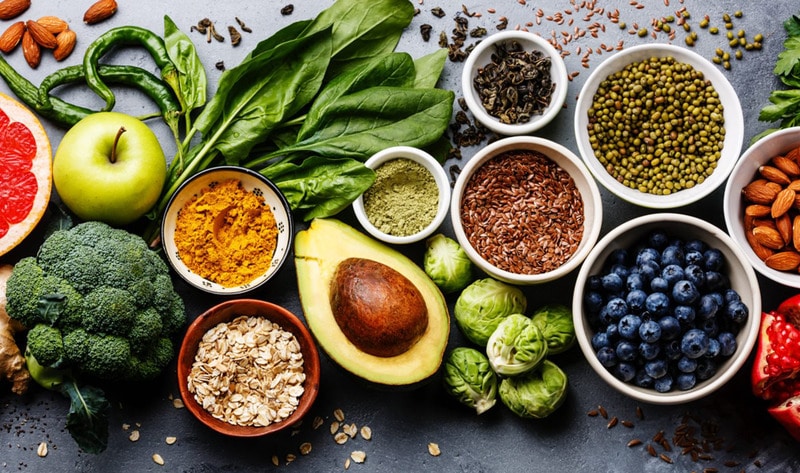
A proper ketogenic diet plan requires more than just fat and protein. We explain what keto vegetables are, how they fit into the keto lifestyle, and some easy ways to prepare them.
How is following a ketogenic diet plan different from following a high protein, low carbohydrate plan? When the ketogenic diet plan forces our body to produce ketones, we stop burning carbohydrates for energy and become a fat burner.
Most of the calories on the ketogenic diet plan come from healthy fats with enough protein to maintain muscle mass. But the secret to producing ketones, a state called ketosis, is to consume 20 to 50 net carbohydrates per day. What are net carbs?
Carbohydrates are sugars, starches or fibres. However, the ketogenic diet plan combines sugar and starch. Starches are simple long sugar molecules that turn into glucose during digestion. They’re not sweet, but they can still raise blood sugar.
Fats and proteins contain little or no carbohydrates and not enough of all the vitamins, minerals and other nutrients we need. This is where keto vegetables come into play.
Keto vegetables are also low in carbohydrates. But they are healthy and important for feeding the millions of gut bacteria that help digest our food, strengthen our immune system, and keep us alive.
Fortunately, the difference between keto-friendly vegetables and keto-friendly vegetables is not eating. Simply put, the edible portion of most low-carb vegetables is above the soil line.
But like all expansions, there are exceptions. These include peas, broad beans and other legumes, squash, pumpkin and sweet corn. However, vegetables prohibited on the ketogenic diet are mostly starchy, such as yams, yams, yams, radishes and carrots.
Keto Vegetable Shop
Good News? Many vegetables are low in net carbs, so you’re unlikely to get bored on a ketogenic diet plan. Especially if weight loss continues!
Here’s a list of our ready-to-eat products, many of which are our favorites, along with total and net carbohydrates based on carbohydrate and fiber content per 100-gram, 3.5-ounce serving, taken from the USDA National Nutrient Database:
Leafy Greens
Of them all. Keto vegetables, dark leafy greens are the most nutritious foods per serving. They are rich in fiber and very low in net carbohydrates.
Kale (4.4 g total, 0.3 g net): Rich in vitamins A, C and K, kale pairs best with other tangy flavors. Consider eggs benedict for breakfast with kale sauteed with bacon and garlic. Or how about grilled zucchini garnished with kale, pine nuts, grated Parmesan cheese and olive oil pesto?
Spinach (3.6g gross, 1.4g net): Try Popeye’s favorite green leaf coated in light coconut cream and sauteed with olive oil, garlic, and lemon juice, or baked with Florentine eggs. Prepare the entire salad, tossing spinach leaves, crumbled bacon, sliced mushrooms and hard-boiled eggs with a dressing of spicy mustard, warm bacon fat and red wine vinegar.
Swiss Chard (3.7 g gross, 2.1 g net): Keto meal prep’s answer to sandwiches and taco shells, Swiss chard leaves are large enough to hold your favorite Asian, Latin American, or Middle Eastern-inspired lettering. Because they’re so low in net carbs, a handful of Swiss chard can make enough burritos to last you a week!
Keto Vegetables as Comfort Food
Keto dieters can enjoy the flavor and texture of mashed potatoes, pasta, and other favorites with these ideas for preparing low-carb vegetables:
Cauliflower (5 g total, 3 g net)): Needs starch The go-to solution for keto followers. Gently boiled and pureed with butter and grated cheese, it perfectly mimics mashed potatoes with only 20% net carbs!
Zucchini (3.1 g gross, 2.1 g net): Zucchini noodles are a sensible keto meal. Instead, try low-carb pumpkin zoodles. It makes a passable pasta when put through a spiralizer and combined with your favorite red or white fish.
Spaghetti Squash (6.9 g gross, 5.4 g net): Don’t have a spiralizer? Cook spaghetti squash and shred it with a fork for instant low-carb pasta. Pair with Italian, Mexican or Asian sauces; This zucchini is perfect for them all! Remember that zucchini has more than twice the carbs.
Cucumbers (3.6 g gross, 3.1 g net): Crunchy, salty, and worried about combining the sauce they make? Toss the slices in olive oil, sprinkle with our favorite spices and grated cheese, and place them in the dehydrator overnight. To look! The perfect container for low-carb sour cream and onion dip.
Keto Vegetables as Snack Food
These make-ahead keto veggies are great finger foods. Use these for parties or as snacks.
Celery stalks (3 g gross, 1.4 g net) cut into 4-inch lengths and stuffed with:
Grass-fed cream cheese, blended with fresh herbs and garlic, or
Softened goat cheese, topped with Tapenate and chopped walnuts, sprinkle . with chopped walnuts, fresh rosemary and thyme leaves or
Natural Unsweetened Peanut or Almond Butter.
Sweet Red Mini Peppers (6.3g total, 4.2g net) cut in half lengthwise, stems and seeds removed, make good “scoops” for mayonnaise, sour cream, and taco-style sauces.
Guacamole and Cucumber Chips (avocado total weight 8.6 g, weight 1.6 g; potato chips total weight 3.6 g, weight 3.1 g): Although avocados are fruits, avocados are rich in fiber and heart-healthy monounsaturated fats. and contains polyunsaturated fats. . Lime juice, chopped onion and garlic, cilantro, and a hint of diced tomato color make this a delicious holiday snack! Episode
Why the Keto Diet is Important for Keto Success